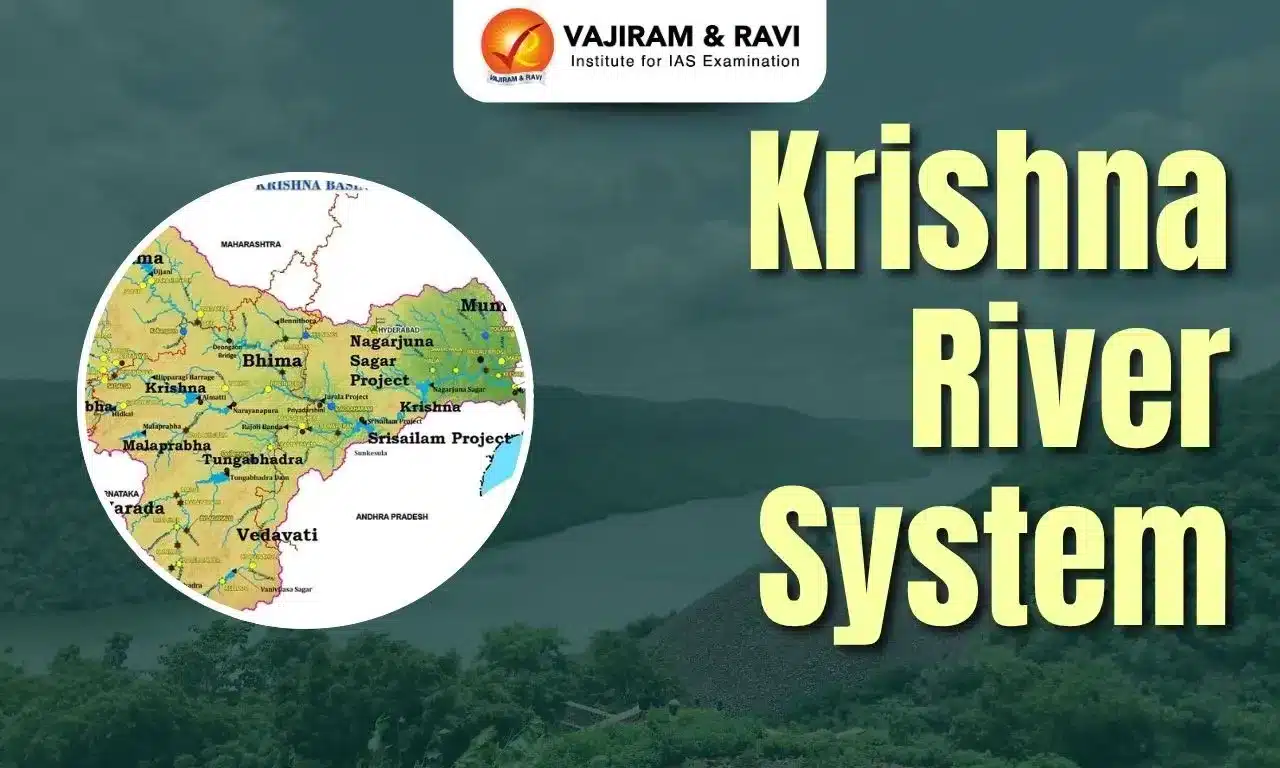The Krishna River System is one of the major river basins in Peninsular India, spanning approximately 1,400 km through the western and southern regions of the country. It plays a major role in agriculture, industry, and sustaining millions of people across multiple states. This article provides a detailed study of the origin, tributaries, and major dams related to the Krishna River initiated by the government of India.
Krishna River System
The Krishna River System is flowing through four states of Peninsular India, originating from Mahabaleshwar in Maharashtra, it travels 1,400 km, travelling through Karnataka and Telangana, before reaching Krishna district in Andhra Pradesh, where it merges into the Bay of Bengal. The river has the highest flow in Andhra Pradesh and covers 8% of India's total geographical area, with 75% of its water being used for agriculture and other purposes.
The Krishna River has various tributaries, with Tungabhadra and Bhima being the most significant. Tungabhadra, a right-bank tributary, flows for about 531 km before merging with the Krishna, while Bhima, the largest left-bank tributary, covers 861 km before joining the main river.
Krishna River System Origin
The Krishna River System originates from the Western Ghats, with its source at Jor village in Mahabaleshwar, located in the Satara district of Maharashtra. From there, the river flows through Maharashtra, then enters Karnataka, followed by Telangana. It then forms the border between Telangana and Andhra Pradesh before finally merging into the Bay of Bengal at Hamsaladeevi in Krishna district, Andhra Pradesh.
Krishna River System Tributaries
The Krishna River System is one of India's major river systems, with several tributaries classified into left-bank and right-bank tributaries. The Tungabhadra River is the largest right-bank tributary, formed by the confluence of the Tunga and Bhadra rivers, and it joins the Krishna River after covering 531 km. Whereas, the largest left-bank tributary is the Bhima River, which flows for 861 km before merging with the Krishna.
| Krishna River System Tributaries | |
| Tributary Name | Description |
|
Panchganga River |
|
|
Koyna River |
|
|
Bhima River |
|
|
Tungabhadra River |
|
|
Ghataprabha River |
|
|
Dudhganga River |
|
|
Malaprabha River |
|
|
Musi River |
|
Krishna River System Dams
The Krishna River is one of India's longest rivers which originates from the Western Ghats. It flows through seven states before emptying into the Bay of Bengal. Check out the table below to learn more about the Krishna River System Dams:
| Krishna River System Dams | |
| Dam Name | Description |
|
Almatti Dam |
Located in Karnataka, this dam is a key component of the Upper Krishna Irrigation Project, providing water for irrigation and hydroelectric power generation. |
|
Srisailam Dam |
One of India’s largest hydroelectric projects, located on the border of Telangana and Andhra Pradesh, supports irrigation, power generation, and flood control. |
|
Nagarjuna Sagar Dam |
Located in Andhra Pradesh and Telangana, playing a crucial role in irrigation and hydroelectric power generation; one of the world's largest dams. |
|
Prakasam Barrage |
Built across the Krishna River in Vijayawada, Andhra Pradesh; regulates water flow and supports the Krishna Delta irrigation system. |
Last updated on December, 2025
→ Check out the latest UPSC Syllabus 2026 here.
→ Join Vajiram & Ravi’s Interview Guidance Programme for expert help to crack your final UPSC stage.
→ UPSC Mains Result 2025 is now out.
→ UPSC Notification 2026 is scheduled to be released on January 14, 2026.
→ UPSC Calendar 2026 is released on 15th May, 2025.
→ UPSC Prelims 2026 will be conducted on 24th May, 2026 & UPSC Mains 2026 will be conducted on 21st August 2026.
→ The UPSC Selection Process is of 3 stages-Prelims, Mains and Interview.
→ UPSC Result 2024 is released with latest UPSC Marksheet 2024. Check Now!
→ UPSC Toppers List 2024 is released now. Shakti Dubey is UPSC AIR 1 2024 Topper.
→ Also check Best IAS Coaching in Delhi
Krishna River System FAQs
Q1. What is the Krishna River system?+
Q2. What is the Narmada river system?+
Q3. What are the tributaries of Krishna's left and right bank?+
Q4. Which state Krishna River does not flow?+
Q5. Which dam is built on Krishna River?+
Tags: Krishna River System

















